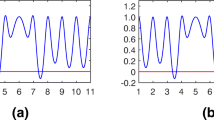Abstract
A new method for smoothly connecting different patches on triangle meshes with arbitrary connectivity, called mesh blending, is presented. A major feature of mesh blending is to move vertices of the blending region to a virtual blending surface by choosing an appropriate parameterization of those vertices. Once blending is completed, the parameterization optimization is performed to perfect the final meshes. Combining mesh blending with multiresolution techniques, an effective blending technique for meshes is obtained. Our method has several advantages: (1) the user can intuitively control the blending result using different blending radii, (2) the shape of cross-section curves can be adjusted to flexibly design complex models, and (3) the resulting mesh has the same connectivity as the original mesh. In this paper, some examples about smoothing, sharpening, and mesh editing show the efficiency of the method.
Similar content being viewed by others
References
Alliez P, Meyer M, Desbrun M (2002) Interactive geometry remeshing. In: Proceedings of SIGGRAPH’02, pp 347–354
Amenta N, Bern M (1999) Surface reconstruction by Voronoi filtering. Discrete Comput Geom 22(4):481–504
Barnhill RE, Farin GE, Chen Q (1993) Constant-radius blending of parametric surfaces. In: Farin GE, Hagen H, Noltemeier H (eds) Geometrie modeling. Springer, Berlin Heidelberg New York, pp 1–20
Bernardini F, Mittleman J, Rushmeier H, Silva C, Taubin G (1999) The ball-pivoting algorithm for surface reconstruction. IEEE Trans Visual Comput Graph 5(4):349–359
Biermann H, Kristjansson D, Zorin D (2001) Approximate boolean operations on free-form solids. In: Proceedings of SIGGRAPH’01, pp 185–194
Botsch M, Kobbelt L (2001) Resampling feature and blend regions in polygonal meshes for surface anti-aliasing. In: Proceedings of Eurographics’01, pp 402–410
Choi BK, Ju SY (1989) Constant-radius blending in surface modeling. Comput Aided Des 21(4):213–220
Clarenz U, Diewald U, Rumpf M (2000) Anisotropic geometric diffusion in surface processing. In: Proceedings of IEEE Visualization 2000, Salt Lake City, UT, pp 397–405
Desbrun M, Meyer M, Schröder P, Barr A (1999) Implicit fairing of irregular meshes using diffusion and curvature flow. In: Proceedings of SIGGRAPH’99, pp 317–324
Desbrun M, Meyer M, Schröder P, Barr AH (2000) Anisotropic feature-preserving denoising of height fields and bivariate data. In: Proceedings of Graphics Interface 2000, pp 145–152
Desbrun M, Meyer M, Alliez P (2002) Intrinsic parameterizations of surface meshes. Comput Graph Forum 21(3):209–218
Floater M (1997) Parameterization and smooth approximation of surface triangulations. Comput Aided Geom Des 14(3):231–250
Floater M (2003) Mean value coordinates. Comput Aided Geom Des 20(1):19–27
Guskov I, Sweldens W, Schröder P (1999) Multiresolution signal processing for meshes. In: Proceedings of SIGGRAPH’99, pp 325–334
Hartmann E (2001) Parametric Gn-blending curves and surfaces. Visual Comput 17(1):1–13
Hermann T (1992) Rolling ball blends and self-intersections. In: Warren JD (eds) Curves and Surfaces in Computer Vision and Graphics III SPIE, pp 204–209
Jones TR, Durand F, Desbrun M (2003) Non-iterative, feature-preserving mesh smoothing. In: Proceedings of SIGGRAPH’03, pp 943–949
Kobbelt L, Botsch M (2000) An interactive approach to point cloud triangulation. In: Proceedings of Eurographics’00, pp 479–487
Levin A (1999) Combined subdivision schemes for the design of surfaces satisfying boundary conditions. Comput Aided Geom Des 16(5):345–354
Lévy B (2003) Dual domain extrapolation. In: Proceedings of SIGGRAPH’03, pp 364–369
Lukács G (1997) Differential geometry of G1 variable radius rolling ball blend surfaces. Comput Aided Geom Des 15(6):585–613
Maekawa T (1999) An overview of offset curves and surfaces. Comput Aided Des 31(2):165–173
Möller T (1997) A fast triangle-triangle intersection test. J Graph Tools 2(2):25–30
Museth K, Breen DE, Whitaker RT, Barr AH (2002) Level set surface editing operators. In: Proceedings of SIGGRAPH’02, pp 330–338
Nomura M, Hamada N (2001) Feature edge extraction from 3D triangular meshes using a thinning algorithm. In: Proceedings of SPIE conference on vision geometry X, SPIE 4476:34–41
Ohtake Y, Belyaev A, Bogaevski I (2001) Mesh regularization and adaptive smoothing. Comput Aided Des 33(11):789–800
O’Rourke J (1994) Computational geometry in C. Cambridge University Press, Cambridge, UK
Park H, Kim K, Lee S-C (2000) A method for approximate NURBS curve compatibility based on multiple curve refitting. Comput Aided Des 32(4):237–252
Piegl L, Tiller W (1997) The NURBS book. Springer, Berlin Heidelberg New York
Rossignac JR, Requicha AAG (1984) Constant-radius blending in solid modeling. In: Proceedings of Computers in Mechanical Engineering, 3 July 1984, pp 65–73
Schneider R, Kobbelt L (2001) Geometric fairing of irregular meshes for free-form surface design. Comput Aided Geom Des 18(4):359–379
Shlafman S, Tal A, Katz S (2002) Metamorphosis of polyhedral surfaces using decomposition. Comput Graph Forum 21(3):219–228
Taubin G (1995) A signal processing approach to fair surface design. In: Proceedings of SIGGRAPH’95, pp 351–358
Várady T, Vida J, Martin RR (1989) Parametric blending in a boundary representation solid modeler. In: Handscomb, DC(eds) The mathematics of surfaces III. Oxford University Press, Oxford, UK, pp 171–197
Vida J, Martin RR, Várady T (1994) A survey of blending methods that use parametric surfaces. Comput Aided Des 26(5):341–365
Wu T, Zhou Y (2000) On blending of several quadratic algebraic surfaces. Comput Aided Geom Des 17(8):759–766
Yu Y, Zhou K, Xu D, Shi X, Bao H, Guo B, Shum HY (2004) Mesh editing with poisson-based gradient field manipulation. In: Proceedings of SIGGRAPH’04, pp 644–651
Author information
Authors and Affiliations
Corresponding author
Rights and permissions
About this article
Cite this article
Liu, YS., Zhang, H., Yong, JH. et al. Mesh blending. Visual Comput 21, 915–927 (2005). https://doi.org/10.1007/s00371-005-0306-2
Published:
Issue Date:
DOI: https://doi.org/10.1007/s00371-005-0306-2




